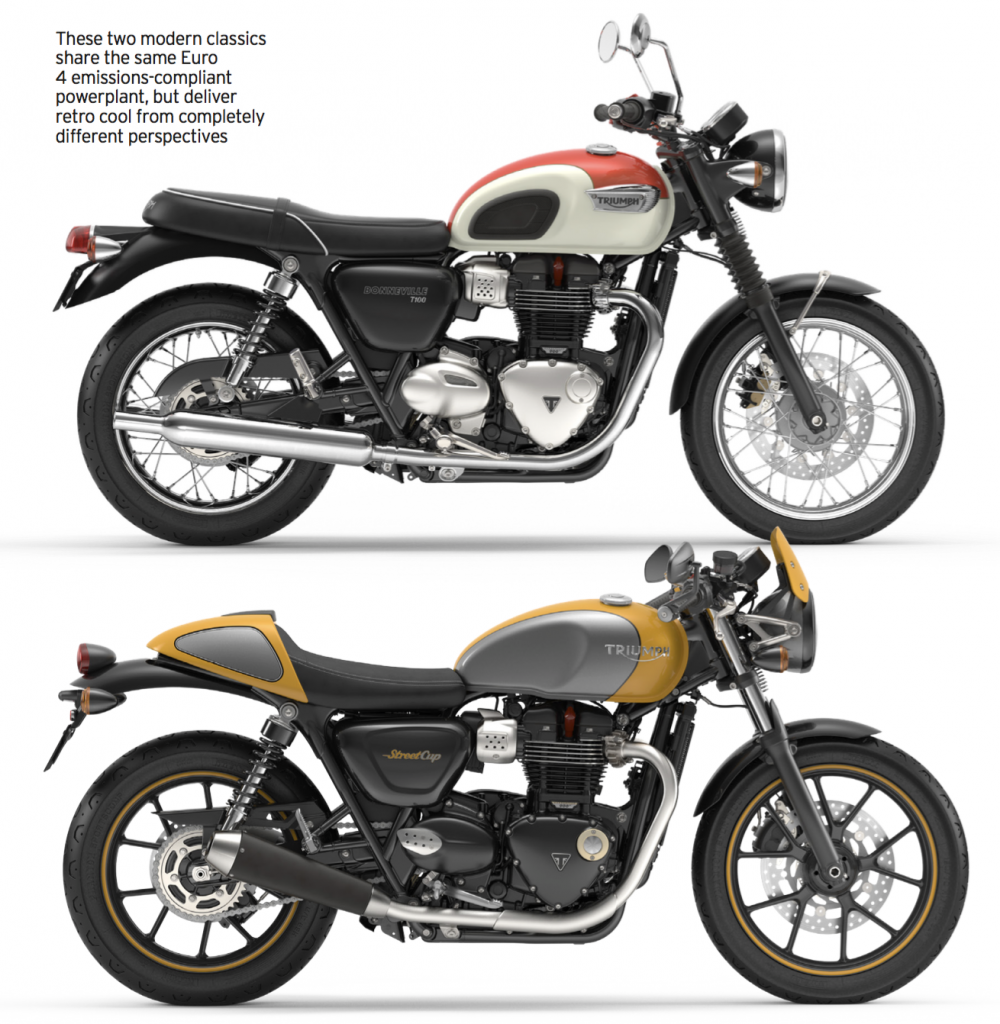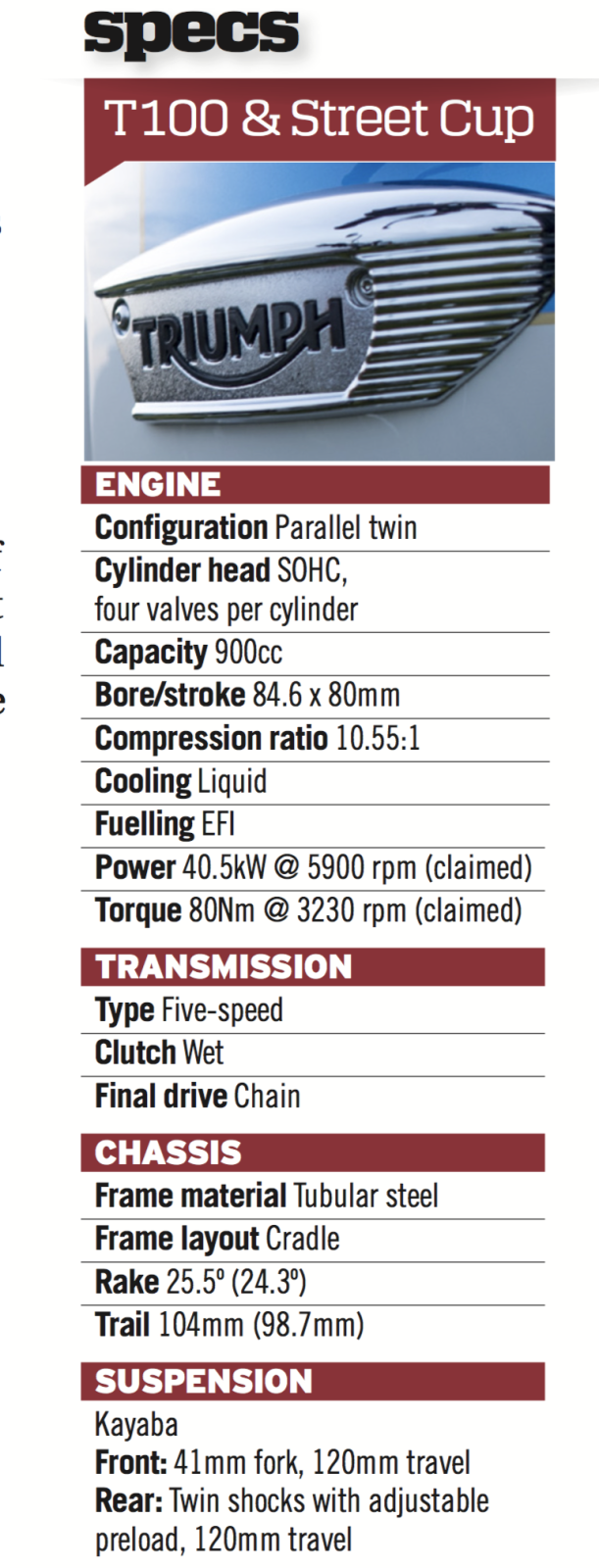With the Bonneville T100 and Street Cup, Triumph continues to redefine what we expect from a modern classic
The 2017 Triumph T100 may be a smaller version of last year’s new T120, but the ‘Mini-Bonnie’ moniker is a bit of a misnomer. For a start, it’s packing a liquid-cooled 900cc engine that delivers 18 per cent more torque than last year’s 865cc T100 (80Nm at 3230rpm versus 68Nm at 5800rpm). There’s also a price hike from $14,250 +ORC for the outgoing model to $15,300 +ORC (or $15,500 +ORC for the T100 Black), however, once you start reeling through the list of improvements it is justified.
In addition to the capacity increase, the new engine incorporates ride-by-wire technology to meet Euro 4 emissions rules, and a 270° firing interval. The change to liquid cooling is barely perceptible because the forward-facing radiator is only slightly larger than the oil cooler on previous models, and fits snugly between the frame stays with its associated pipework channelled discreetly to the engine. Air-cooling fins have been retained to keep the ‘period’ look and also help supplement the small radiator.
According to Triumph’s Technical Manager Cliff Stovall, the new 900cc parallel-twin platform delivers “a better burn that exceeds the emissions regulations and provides excellent mileage”.
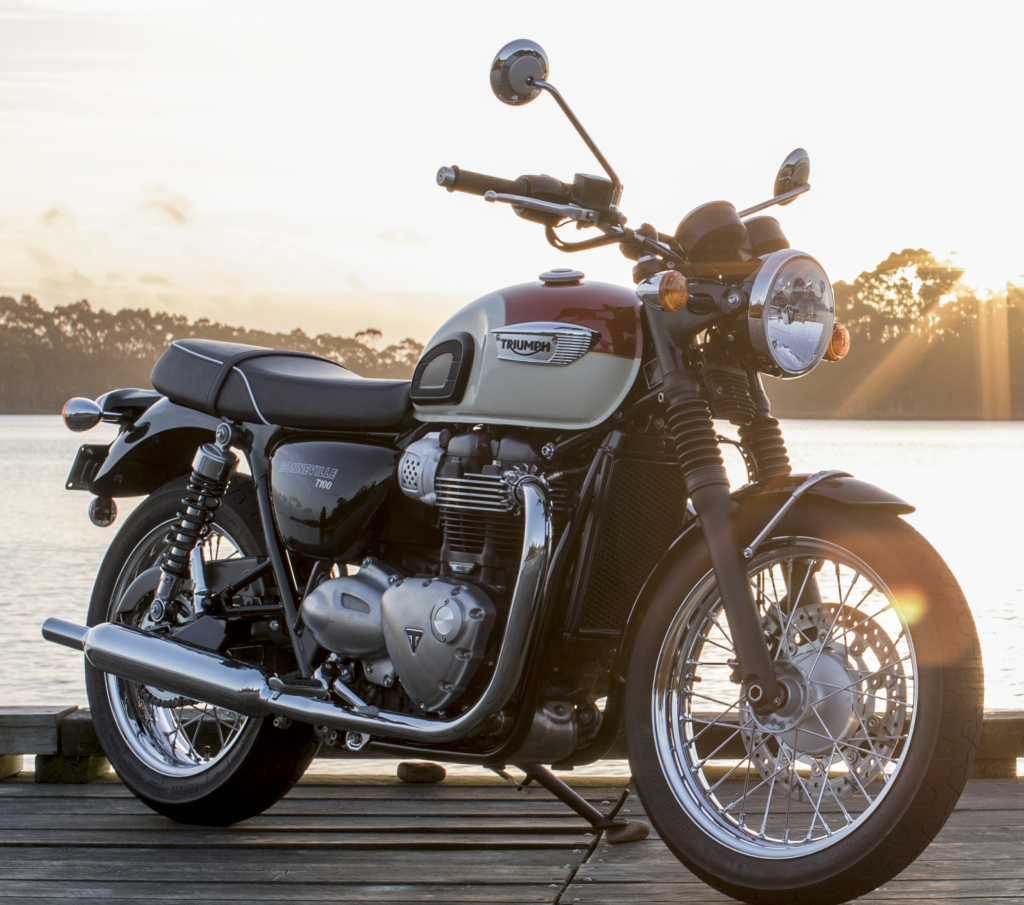
Fuel consumption is cited as 3.8L/100km under controlled test conditions, but we saw figures of 4.6L/100km during the launch. That could be interpreted as a worst-case scenario given that we were sampling some of the best roads Tasmania has to offer.
Regardless, the 14.5-litre tank should be good for a range of at least 250km, on par with that of the previous 16-litre unit, and there’s now a locking fuel cap included. The ‘chipped’ ignition key opens said cap, engages the steering lock via the ignition barrel, and removes the comfortable bench seat for access to a 12V USB charger, so owners only require the one key this time around – a small but significant example of improved design.
The most welcome change though, and one which everyone will immediately notice, is the vastly improved handling. Triumph have downsized the front wire wheel from 19 to 18 inches in an effort to help the Bonnie turn in, and this change is supported by other improvements that include the addition of a longer cartridge-style 41mm Kayaba fork with revised head angle for steeper rake (25.5°) and less trail (104mm). It also holds its line better through corners due to a stiffer tubular steel frame, preload- adjustable twin rear shocks, and a shorter wheelbase, reduced by 50mm to 1450mm.

The non-switchable ABS is non-intrusive, and thanks to the stiffer front end there’s limited fork dive, which was cited as an issue with the outgoing model. The 310mm single disc and axially- mounted two-piston Nissin caliper requires considerable force at the lever to pull the almost 230 kg wet weight of this machine to a rapid stop, but that’s par for the course with a single disc set-up.
These attributes make it possible to ride the Bonnie like a modern machine, but once you start grinding down the rubber- lined footpegs in the tight stuff, you’re quickly reminded that it is still a ‘modern classic’. Wide ’bars and low centre of mass make it easy to manoeuvre at slow urban speeds and the character-filled twin-skin peashooters play a smooth and throaty tune. The T100 gets top marks for the comfortable ’peg position and wide bench seat, both of which make the Bonnie equally suitable for two-up touring or spending all day in the saddle riding solo. The switchable (on/off ) traction control can’t be changed on the fly, but I still rolled in to our lunch stop impressed with the Bonnie’s versatility on vintage road surfaces after testing the system along more than 30km of unsealed track.
Chrome bezels set off the twin analogue dials for the speedometer and rev counter, and both contain LCD displays packed with 21st-century information. And in addition to the more traditional two-tone or jet black colour options with hand-painted pinstriping on the tank, Triumph is also enticing a younger, dare I say cooler, market with its stealth-looking T100 Black that uses understated matte black paintwork, blacked-out engine cases, and powder-coated pipes to great effect.
The rubber knee pads and ‘harmonica’ badge emblazoned on the teardrop-shaped tank are pure heritage, and with more than 150 accessories to choose from there’s potential to transform both the standard or ‘Black’ Bonnie into an original build without the kind of knuckle grazing and part modifying antics that most of us are accustomed to. As an all-rounder I’d say the T100 well and truly lives up to the model’s heritage, and for $15,300-$15,500 (+ORC), it’s well priced for the added performance it offers in comparison to Ducati’s Scrambler Classic ($15,490 +ORC), Moto Guzzi’s V7 II Stone ($14,000 +ORC) or Kawasaki’s W800 SE ($12,499 +ORC), which are all competing for a slice of the modern classic pie.
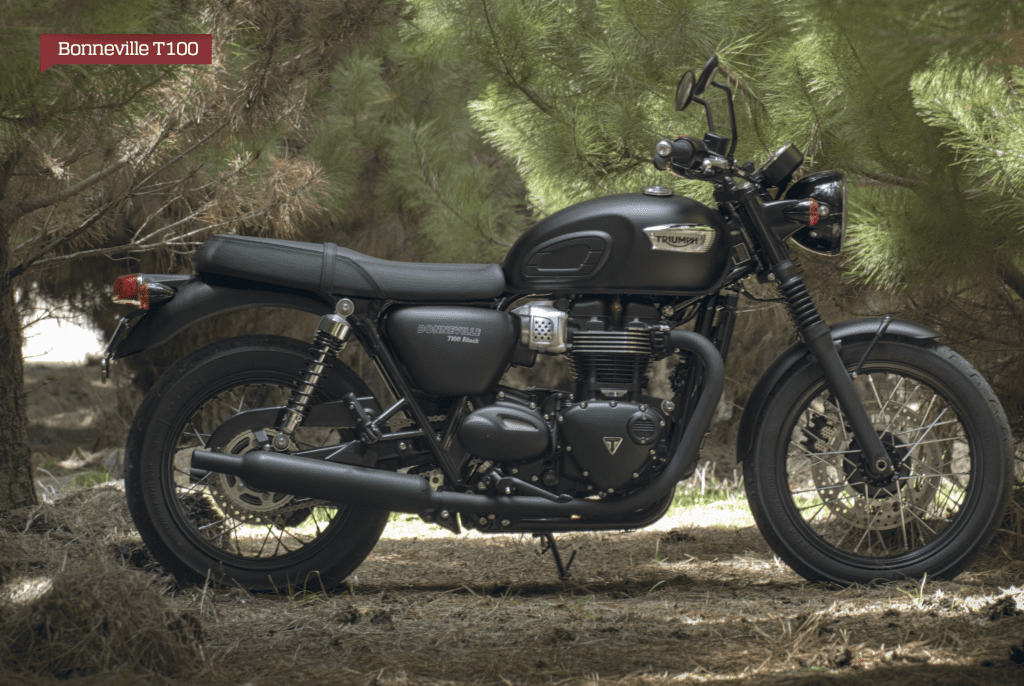
Triumph Street Cup.
While it has the same powerplant as the T100, it is worlds apart in terms of feel, application and even perceived performance. Weighing in at 200kg dry, it uses a combination of parts from Triumph’s modern classic family to offer café racer geometry and deliver a riding experience to match the styling. The bike benefits from the more compact and rigid frame of Triumph’s 2016 Street Twin, along with longer rear shocks, Thruxton-style rearsets, and dropped ‘Ace’-style ’bars.
Despite this blend of components, it was refreshing to discover that commuting abilities hadn’t been overlooked either. When we first rode the Street Cup to escape from Hobart’s congested CBD, the low seat height (780mm) and smooth, predictable power delivery came to the fore. This café racer remains well suited for stop-start urban riding, and was also surprisingly comfortable on the open road for highway cruising and the odd touring stretch.Despite this flexibility, it didn’t take long on Tasmania’s fast-flowing mountain roads to realise that the Street Cup’s strengths are indeed centred around real-roads racing. The lower and slightly more forward drop ’bars give this package an involved riding position, but it still feels natural – even for those of us with unnaturally long limbs.
On first inspection, the Street Cup resembles a T100 with different wheels, pipes and bodywork. But take a closer look and you’ll see other differences that produce nimbler handling and a more engaging riding experience.
The preload-adjustable twin-shocks are longer than those used on the T100 but retain the same 120mm of travel. This creates a higher rear ride height and steepened head angle (rake 24.3°/trail 98.7mm) which places more weight onto the Pirelli Phantom Sportcomp front tyre for better feel and more confidence when slicing through curves. This differentiates it from the more relaxed geometry of the Bonneville T100. Changes of direction are achievable with just slight pressure on either ’bar end, which is further assisted by lighter split-spoke cast alloy wheels, and a 15mm shorter wheelbase.
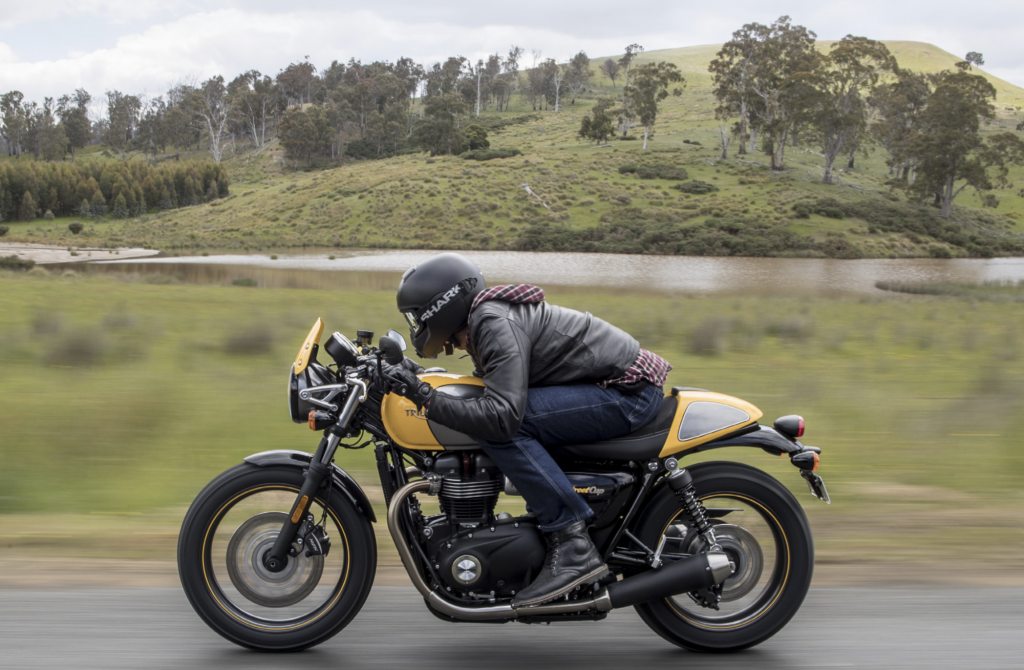
Like on the T100, the engine cases receive Hinckley’s premium badging, but the fork gaiters have been swapped out for some more robust looking protective sleeves, and the streamlined dimensions are accentuated by a smaller 12-litre fuel tank. Consumption was measured at 5.1L/100km over more than 400km of hard road riding, and although this falls short of Triumph’s claimed 3.7L/100km obtained under test conditions, it is comforting to know that the Street Cup will still see a range of at least 230km.
The slip-assist clutch is the same highly effective and supple unit in the Bonnie T100, which employs engine torque to assist in engaging the clutch so that three light-duty springs can be used to make the initial contact. It works exceptionally well, and even when you’re banging down the gears like a supermoto racer, the clutch will freewheel to prevent the rear wheel from locking up. Twin counterbalance shafts positioned fore and aft of the crank dampen out any vibration from the parallel twin, and despite the modest peak power figures for this 900cc mill, it’s extremely fun to ride and will still reach speeds in excess of 165km/h for those who want to use it on a closed circuit.
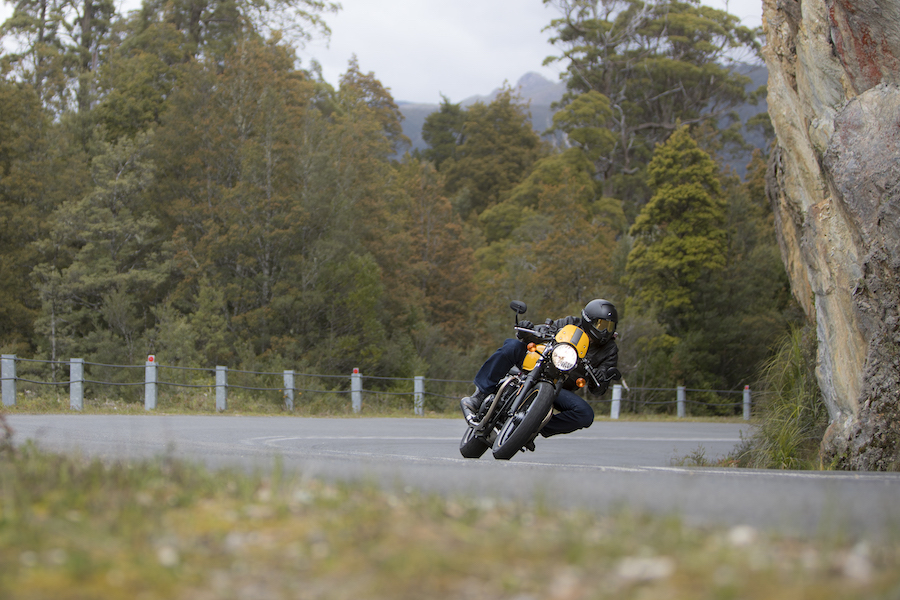
Both of these new modern classics are manufactured in Thailand, but the design process continues to take place in England and Triumph’s attention to detail can only be described as top notch. The Street Cup’s clean lines are maintained by some clever engineering that obscures the catalytic converter beneath a brushed stainless steel header cover to retain the ‘period’ look. The Alcantara-effect bullet seat is set off with silver stitching and a single seat cowl that is finished with a race number board in a very fitting TT touch. Add to that a small flyscreen with racing stripe, billet machined ’bar-end mirrors that actually work, and adjustable levers, and you have what could already be considered a finished product – until of course you start scrolling through more than 120 Street Cup accessories in the catalogue. There is an aftermarket Vance & Hines exhaust system for this model available from Triumph, but the stock 2-2 megaphones already emit a wicked howl that is totally addictive and very different to that of the T100’s peashooters.
Bright yellow and silver paintwork is bold and eye-catching and there’s also a classy black and silver option for those who prefer a more understated look. Riding the Street Cup was an eye-opening experience for this self-confessed retro-phobe, and while it is slightly more expensive than the Bonnie at $15,600 +ORC, those who enjoy pushing the envelope will find it’s worth every penny.
By Paul McCann

